Skip to comments.
Army Seeks Short-Term Payoff From Future Combat Systems
National Defense Magazine ^
| December 2003
| Sandra I. Erwin
Posted on 11/23/2003 5:19:13 AM PST by Cannoneer No. 4
The Army is redirecting priorities in the Future Combat Systems program, in an attempt to meet short-term needs for new technologies. This shift in emphasis means the program will be less about developing futuristic concepts and more about upgrading the current tanks, armored infantry vehicles and trucks.
Program officials assert that the chief of staff of the Army, Gen. Peter J. Schoomaker, supports the FCS and intends to keep the $15 billion project on track to field a new family of vehicles by 2010. But the ongoing wars in Iraq and Afghanistan clearly have forced the Army to reassess the program goals. While the FCS previously was viewed as a long-term modernization effort, now the chief wants FCS to begin delivering technologies as soon as possible.
The plan is to “spin off capabilities” out of FCS into the Abrams tank and Bradley infantry vehicle fleets, said Lt. Gen. John S. Caldwell Jr., military deputy to the assistant secretary of the Army for acquisition. But he cautioned that the FCS program is not being significantly restructured or downscaled. Rather, other programs will be “adjusted” to take advantage of the new technologies developed in FCS, Caldwell told National Defense.
Since the FCS got under way more than three years ago, the predominant message heard from senior officials has been the notion of FCS as a “network” or a “system of systems” that would usher the Army into the information age.
Each FCS brigade, called a unit of action, will run 30 million lines of software. More than half of the money in the program will be allocated to ground combat vehicles and C4ISR (command, control, communications, intelligence, surveillance and reconnaissance) systems.
A seamless network of light ground vehicles and aircraft remains the essence of the FCS, but program officials now are stressing that FCS is first and foremost about putting technology in the hands of soldiers. During an industry conference last month sponsored by the Army Tank-Automotive and Armaments Command, in Dearborn, Mich., the program manager for FCS, Brig. Gen. Donald F. Schenk, told contactors that they “need to work fast.”
Despite widespread skepticism that the program may not be able to deliver a new generation of vehicles to begin replacing tanks and Bradleys in less than a decade, Schenk said that the goals are achievable. But in his opening comments to the conference, he acknowledged that, with the Army at war, the focus has changed. The technologies of the FCS could “transition” to other programs “more quickly than most people think,” Schenk said.
Among the technologies that could “spiral” from FCS into the current force are wireless communications systems, active protection for vehicles, diagnostics devices to predict engine failures, hybrid-electric power units and advanced truck suspensions, said Albert Puzzuoli, deputy program executive officer for Army ground combat systems.
But for FCS to be successful, he stressed, the Army and its contractors must fix a vexing problem that affects today’s weapons systems: electronics obsolescence. The term refers to the difficulties in upgrading older weapon systems because the electronic components often are out of production and not available in the commercial market. This could pose serious hurdles as the Army figures out how to upgrade the Abrams and the Bradley, so they can remain in the fleet for at least 20 more years.
The Army’s ability to “spiral” technologies out of FCS into Abrams and Bradley depends on “how we attack our electronic obsolescence problems,” Puzzuoli told the TACOM conference. One solution would be to develop a new, less complex electronic architecture in the Abrams and Bradley that is “somewhat compatible” with FCS, he said.
Unless this matter is resolved, he added, “FCS, one day, will suffer electronic obsolescence issues.”
Puzzuoli suggested that one of the more pressing technology needs in the near future will be to equip the Abrams tanks with new or remanufactured engines. The Army had awarded a contract to Honeywell Corp. in 1999 to develop a new turbine engine, the LV100. The plan was to build 1,600 engines to be installed on all Abrams tanks and Crusader artillery vehicles. But the cancellation of Crusader and cutbacks in the Abrams upgrade program drove down the number of engines to fewer than 600. An expected higher price for the LV100 (as a result of a smaller order) and technical problems experienced in the program have prompted the Army to reassess whether it should cancel the project and start over.
“We are currently evaluating the status of that program and where the future lies,” Puzzuoli said.
The current engine, the AGT1500 turbine, is fuel guzzling, has poor reliability and high maintenance costs, he said.
In fiscal year 2004, the Army will need to overhaul more than 1,200 tank engines, a threefold increase over 12 months. The Anniston Army Depot, in Alabama, currently overhauls about 400 engines a year.
The commander of TACOM, Army Maj. Gen. N. Ross Thompson III, said he fears that shortages of key components could severely undermine the depot’s ability to deliver enough engines to meet the Army’s needs in Iraq.
The potential cancellation of the LV100 is not related to the increased need for AGT1500 engines, Thompson said in an interview. “If they don’t continue the program, we’ll have a competition to reengineer and increase the reliability and the durability of the AGT1500.”
Also of immediate need in the field is additional protection for Humvees and other trucks that are not armored. As U.S. forces in Iraq endure continuing attacks by rocket-propelled grenades, mortars and various explosive devices, TACOM officials are rushing to come up with “countermeasures,” such as armor kits.
Ideally, TACOM would like to build more of the up-armored Humvees, but the production line only can assemble 220 per month. The Army has asked for at least 3,500.
Until enough up-armored Humvees can be delivered, TACOM is providing interim alternatives, such as armor kits and a newly designed armor door that can be applied on existing Humvees. The Army’s depots will make 1,000 armor doors for immediate delivery to Iraq, Thompson said.
Armor kits also will be needed for medium and heavy trucks, he said. Future Army rotations in Iraq will see fewer Abrams and Bradleys, and more wheeled vehicles, including the new Stryker.
Upgrading Vehicles
Contractors, meanwhile, await specific direction from the Army on how it will go about transitioning from the current force to the so-called Future Force, equipped with FCS technology.
Much of the technology the Army wants in FCS already exists, experts contend. Vehicle manufacturers are coming forward with unsolicited concepts that aim to prove that.
United Defense LP, for example, recently unveiled a 20-ton armored vehicle equipped with a 120 mm gun that was fired at a shooting range in California, according the UDLP officials. The demonstrator—powered by a hybrid-electric engine—is a modified armored gun that originally was developed in the early 1990s for Army light forces and subsequently was cancelled to fund other programs.
UDLP resurrected one of the six 105 mm prototypes and installed a 120 mm gun designed at the Army’s Watervliet Arsenal.
The company claims that the vehicle is not intended to meet FCS requirements, given that the Army selected General Dynamics as the provider of direct-fire vehicles for FCS. UDLP was designated the supplier for the artillery systems.
In what appears to be a tit-for-tat move, General Dynamics unveiled its own concept for a 20-ton 105 mm howitzer, which would be compatible with the Stryker family. Company officials said the Army has not yet settled on whether the FCS howitzer will be 105 mm or 155 mm, even though UDLP is developing a 155 mm non-line-of-sight cannon for FCS.
As far as FCS requirements are concerned, the Army has been “really vague,” said Dean Lockwood, combat vehicles analyst at Forecast International, a market research firm. For that reason, “contractors are showing what is possible and what is not.”
Lockwood believes that the Army is moving toward a hybrid force of light quick-reaction and heavy armored units. “With FCS, they want something in the middle.” Stryker, he said, is the “first incarnation of FCS. It’s the test-bed and interim program for it.”
Marine Lt. Gen. James Cartwright, of the Joint Staff, called FCS “the most transformational thing that is going on in the Department of Defense.”
Given the uncertainty about future conflicts and geopolitics, “the Army knows its goals are probably ambitious,” Cartwright said in a speech to the Institute for Defense and Government Advancement. The schedule may slip, “but they’ve got the right mindset,” said Cartwright. “They’ve got a heck of a challenge.”
TOPICS: Extended News; Foreign Affairs; Government; News/Current Events; War on Terror
KEYWORDS: army; armytranformation; fcs; iraq; miltech; wheeledarmor
Navigation: use the links below to view more comments.
first previous 1-20 ... 101-120, 121-140, 141-160 ... 241-257 next last
To: SLB; blanknoone; archy; Ranger; HiJinx; sauropod
ARMORED WARFARE: Ambush Adjustments in Iraq November 24, 2003: While the number of attacks on U.S. troops in Iraq is small (relative to the number of troops and vehicles there), no one wants to get killed or maimed by a roadside bomb, RPG rocket or rifle bullets. So, in a tradition that began in World War II, troops are modifying their trucks and armored vehicles to provide more protection. The most effective protection is sandbags, as these stop fragments from roadside bombs and reduce the effectiveness of RPG rockets and rifle bullets. Putting sandbags underneath the passenger compartments of vehicles helps protect troops as well. Older flack jackets have proven useful when put over (or inside) the doors of hummers. Units that have access to welding equipment scrounge up metal (there are a lot of junked Iraqi army vehicles lying about), and weld it to trucks. This sort of effort also produces pedestal and ring gun mounts for trucks and hummers.
This points out that, even when getting ambushed, the best defense is often a good offensive. Troops are more alert and have their weapons ready when moving through hostile areas (about a third of Iraq fits that category.) This included training troops how to search in front of their vehicle for signs of an ambush. More binoculars were issued and larger convoys were led by MPs trained at this sort of thing. When possible, helicopters or UAVs flew overhead to spot attackers, and counterattack. One reason for the increased use of roadside bombs has been the growing ability of U.S. troops to spot ambushers and attack first, or respond so quickly and violently to an ambush that most Iraqis lost their heart for it.
One of the minor, but important changes is making sure all your vehicles are painted with the desert colors. Doesn't have to be camouflage pattern, just the tan CARC (Chemical Agent Resistant Coating.) This provides a measure of invisibility in the vast desert areas of Iraqi. CARC is a special paint that resists damage when trucks are decontaminated after they are hit with chemical weapons. Normal automotive paint is damaged when the decontamination fluids are used on it.
Some units have put a hummer in the lead of a convoy with just the driver and sand in the cargo bed and lots of protection added. The sand helps protect the driver if a mine is encountered, although this is only a problem when operating on dirt roads, where mines can be planted without leaving telltale signs. If ambushed, the driver of this lead vehicle has a better chance of surviving, and vehicles behind him can concentrate their fire on the ambushers.
These added defensive measures come at a cost. Additional weight (armor, sandbags, weapons) on the vehicles increases fuel use. The vigilance required while on the road tires the troops out more quickly. But as long there was a recent, or nearby, attack, it's not too difficult to keep everyone alert.
To: jonascord
Many countries refer to the M-113 as Zippos or Ronsons, since they light up, first time... Nah, mate. Zippo tracks were the M113 with flamethrower. Oh, wouldn't that make a nice surprise for some Iraqi feeling lucky!

I know that there have been discussions for years about the hydraulic fluid used. The red oil had a lower vapor ignition temperature, but gave longer life to the trannies.
And was carcinogenic if slopped all over the skin, as when it was used in ammo cans for cleaning weapons bolts and other smallish parts.
In Country, the M-113 was a death trap, with most riding on the outside so you wouldn't be trapped when it hit a mine. Maybe conditions are different in Bagdhad...
True enough but those of us in M48 tanks and M551 Sheridans rode outside, too. The first thing that goes if you're standing in a track or tank that hits a mine is all the bones of your legs as the shock is transmitted from the floor, There;s not much the driver can do about that, but if mines other than Claymores are the most likely threar, riding on top is one common answer. Sone of those command-detonated mines were made fron 500 pound and 750 pound bombs. Like this one; hit a 750-pounder, which blew off both tracks and the turret. You're invited to guess what happens when it's a 15-ton M113 instead of a 52-ton M48 hits a rig like that.

122
posted on
11/24/2003 6:12:27 AM PST
by
archy
(Angiloj! Mia kusenveturilo estas plena da angiloj!)
To: 91B
ping
To: Southack
120mm, 105mm, and 155mm canons do precisely *what* against RPG's, landmines, and IED's?Nothing. They are useful for killing people who would otherwise be trying to use those weapons on us if they were still alive. Do you think tank guns and howitzers are of no use in the kinds of operations being conducted in Iraq? In many operations you are correct, but last week they were calling in air strikes and firing mortars so there are still uses for firepower. Not everyplace we are going to fight in the next 30 years will be like Iraq is right now.
New turbines or diesel engines do precisely what to protect our soldiers and eliminate our enemies?
Mobility gets our soldiers out of trouble faster; gets the Cavalry to the rescue faster, gets weapons to bear on targets faster. Gettin' there firstest with the mostest is no longer important?
We need better mine detection on all of our vehicles, bar none.
Well, FCS is working on remote control vehicles that can precede the manned vehicles and detonate any mine in the road. You would ensure that no vehicle moves without mine rollers attached or a remote control vehicle leading it or dismounted engineers with mine detectors sweeping the road in front of it? How are is anybody supposed to get anywhere at that rate?
We need better situational awareness.
What exactly is situational awareness? I get suspicious when I here that term. It is generally being used by somebody selling some gold-plated, high-tech, contractor-maintained substitute for binoculars.
To: Cannoneer No. 4
What exactly is situational awareness? I get suspicious when I here that term. It is generally being used by somebody selling some gold-plated, high-tech, contractor-maintained substitute for binoculars. Great line. If we focused as much on firepower, mobility and protection as we do on the latest computer or communications gadget in Force XXI or Army After Next we'd be flying in X-wing fighters with force fields by now. The single best thing about the M1A2 in my mind is the independent sight.
After we have all of this situational awareness we seem to have forgotten that someone still has to shoot the bad guys.
To: Cannoneer No. 4
"Mobility gets our soldiers out of trouble faster; gets the Cavalry to the rescue faster, gets weapons to bear on targets faster. Gettin' there firstest with the mostest is no longer important?" It's not that, it's just that you are thinking about the *last* war rather than our present and future battles.
It's not that, it's just that you are thinking about the *last* war rather than our present and future battles.
We're not going up against Soviet main battle tanks. They aren't there. We don't need to be arguing about the penetrating power of the 155mm vs the 120mm or the reload speed of the 105mm. It's not about thicker armour or minutely faster vehicles.
Our fights in SE Asia, Central Asia, the Middle-East, and in Africa are going to be against militia-style amatuers. These guys are going to be using whatever weapons have been left behind by formerly-Soviet-backed forces.
We aren't going to see the enemy mass in force any longer. Our new enemy has to hide from our current military, venturing out only to plant mines, IED's, set booby traps, and lob teh occassional RPG or mortar round.
Our new enemy is going to take the occassional sniper shot, fire off the odd Strella SA-7, and engage in various hit and runs or suicide bombings.
Militarily, these attacks are insignificant. Politically, these attacks let our Leftist press gin up reams of bad publicity for us.
As such, we need to focus our brain power on stopping and besting these expected military and political attacks.
So don't tell me the merits of a turbine over a diesel in an M1A1. The marginal differences in such things matters not a whit. Whether we have one or the other inside our MBT's, we're still going to get hit with the self-same RPG's, mines, IED's, mortars, Katyushkas, AK-47's, and suicide bombers.
Therefor, what I'm telling you is that we, you and me and all of our side, has to change *our* way of thinking (quite possibly the most difficult thing to ask of anyone). We can't keep thinking in our Cold War, Soviet foe battle ways.
Show me how to detect one more mine or IED than we are currently spotting, and that will save one day's headlines from our bloodstained press. Show me how to stop an RPG with new side armor, electric counter measures, or by launch detection, and we've stopped yet more bad press against us as well as saved the lives of soldiers in the field....something that our new body armor has already done against AK-47 rounds.
The glory of fighting big tank versus big tank is gone, perhaps for some great length of time. Now we are squashing gnats who are armed with essentially WW2 technology.
126
posted on
11/24/2003 9:51:16 AM PST
by
Southack
(Media bias means that Castro won't be punished for Cuban war crimes against Black Angolans in Africa)
To: Cannoneer No. 4
Thanks for the ping-reading through the thread to try and find useful suggestions.
127
posted on
11/24/2003 10:07:11 AM PST
by
91B
(NCNG-C/Co 161st ASMB-deployed to theater since April 19th)
To: Southack
you are thinking about the *last* war rather than our present and future battles.They all kind of run together. Weapons, tactics and technologies change from war to war. Humans don't.
We're not going up against Soviet main battle tanks. They aren't there.
We went up against some last spring. Special Forces went up against Taliban T-55's two years ago. Ex-Soviet Main Battle Tanks all over the place. The Red Chinese and the Iranians have a few, too. In the land of the tankless, the old, rusty, raggedy, black smoke-spewing tank is king, unless you have lots of air and Javelins and TOWs.
We don't need to be arguing about the penetrating power of the 155mm vs the 120mm
Agreed. Who is arguing that?
It's not about thicker armour or minutely faster vehicles.
Tell that to General Shinseki. That's what the whole Stryker vs. LAV III and wheels vs. tracks controversy is all about.
Our fights in SE Asia, Central Asia, the Middle-East, and in Africa are going to be against militia-style amatuers.
Are they, now? No doubt some will. The Iranians, Syrians, Libyans, Pakistanis and Egyptians all have armies of some significance.
These guys are going to be using whatever weapons have been left behind by formerly-Soviet-backed forces.
Including the Soviet tanks you said weren't there.
We aren't going to see the enemy mass in force any longer.
I do not believe that is true. It may be true of Iraq. It may even be true of al Qaeda. al Qaeda is not the only enemy we will ever fight from now to the end of time.
Our new enemy has to hide from our current military, venturing out only to plant mines, IED's, set booby traps, and lob teh occassional RPG or mortar round.
Our "new" enemy has been at war with us since 1979. His "new" tactics were well understood by Soviet partisans and Nazi Kopfjaeger 60 years ago.
Militarily, these attacks are insignificant. Politically, these attacks let our Leftist press gin up reams of bad publicity for us.
Our leftist press has many of the same goals as our enemy. They have a symbiotic relationship. 4GW. And these attacks are significant militarily when they cause commanders to be less aggressive for fear of incurring casualties the folks at home have no stomach for.
So don't tell me the merits of a turbine over a diesel in an M1A1.
That post was not addressed to you. Somebody asked, I posted a link. You don't want to read it, don't read it.
The marginal differences in such things matters not a whit.
That such trivialities are of no consequence to you does not necessarily make discussion of "marginal differences" pointless for everybody.
We can't keep thinking in our Cold War, Soviet foe battle ways.
There were several "hot wars' fought during the Cold War. They bear many resemblances to the war in Iraq right now. Much that worked then still works now. The biggest difference is 24-hour sattelite news and no tolerance for friendly casualties. Now when a soldier gets killed it must have been the commander's fault, or the Army's fault, or Rumsfeld's fault, or Bush's fault. Why do so few ever think to blame the enemy?
Show me how to detect one more mine or IED than we are currently spotting, and that will save one day's headlines from our bloodstained press. Show me how to stop an RPG with new side armor, electric counter measures, or by launch detection, and we've stopped yet more bad press against us as
Show me an aggressive, TRUTHFUL, counter-propaganda PR campaign to counter-act the al Qaeda sympathizing press.
128
posted on
11/24/2003 11:30:40 AM PST
by
Cannoneer No. 4
(In the land of the tankless, the old, rusty, raggedy, black smoke spewing tank is king.)
To: Cannoneer No. 4
Thus it is unclear exactly what Thunderbolt is trying to demonstrate. Well, for one thing, you can probably carry more than one of them in a C-5, C-141, or C-17. If you need to get some big guns in-theater, fast, that means a lot. If it is air-droppable, or accomodate LAPPES extraction, it might make a good support system for the 82d. Better than a Stryker anyway.
Still, and MBT need to needs to be that. The thunderbolt might also have a application in the scout role.
129
posted on
11/24/2003 1:31:19 PM PST
by
PsyOp
( Citizenship ought to be reserved for those who carry arms. - Aristotle.)
To: Cannoneer No. 4
Not enough fire power.
To: R. Scott
Not enough fire power. Fit the 25mm gun power turret from an M1025 Bushmaster Humvee. Next problem.

131
posted on
11/24/2003 3:30:15 PM PST
by
archy
(Angiloj! Mia kusenveturilo estas plena da angiloj!)
To: Cannoneer No. 4
Thanks for posting the stuff on vehicle hardening. I printed it all off and am sending it to my daughter at Ft. Hood. She's the driver for the 1st Sgt in her MI unit (She's the NBC NCO). Her unit deploys to Iraq in January and will be going to the Sunni areas north of Bahgdad.
I've been telling her about this stuff (sand-bagging, etc.) but did not remember the FM to reference for her.
Thanks again.
132
posted on
11/24/2003 4:43:20 PM PST
by
PsyOp
( Citizenship ought to be reserved for those who carry arms. - Aristotle.)
To: Cannoneer No. 4
Why are we not using ex-Iraqi Army vehicles?Recce: approximately 600 recce vehicles available including PT-76; AML-60; AML-90; BRDM-1/2; EE-9. AIFV: approximately 800 to 900 BMP-1/2. APCs: possibly 2,000 × APCs including some MT-LB; ERC-90; Panhard M3; PSZH-IV; BTR-50; BTR-60; BTR-152; EE-11; OT-62; OT-64; Walid; Type 531; 20 × M113A1; M-60P; BMD-1.
What a hodgepodge. I can only imagine the variety of maintenance and spares problems, aside from any modifications that might have come from original owners. Sounds like Saddam had to buy anywhere he could to replace his 1991 losses.
PT-76: Tracked amphibious light tank, not particularly more RPG-resistant than a Stryker. Also built by the Chinese, sometimes seen with an 85mm gun instead of the Russian 76mm:
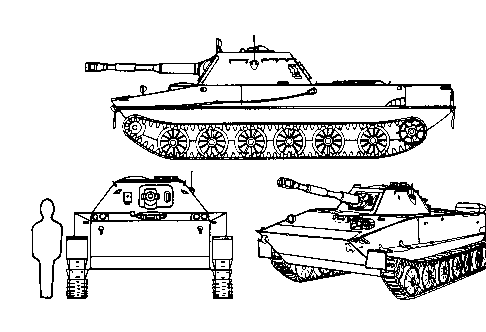
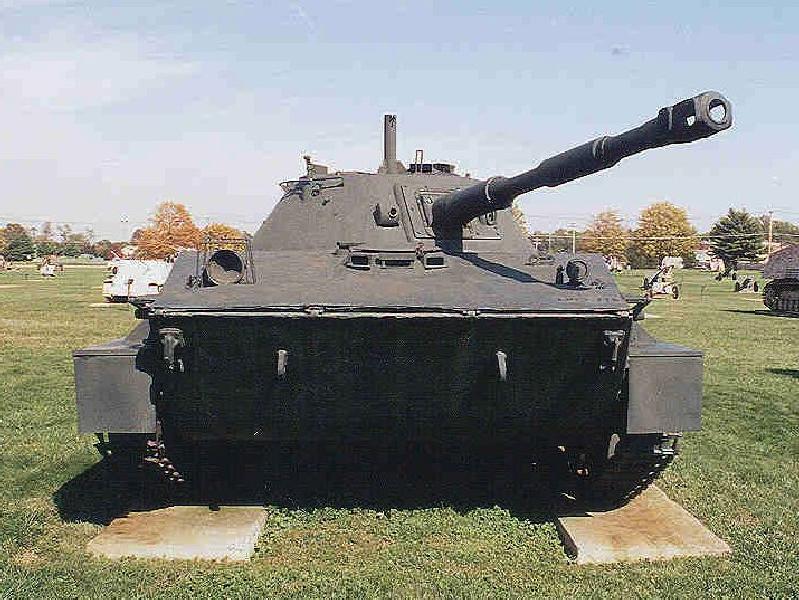
AML-60; AML-90; French 4-wheeled APC, no room for a full squad [there's no room for a full squad in a Humvee, either] and the 90mm gun of the AML-90 uses non US-standard ammo. The French would probably embargo sales of any to us- I'd be REAL doubtful about using captured Iraqi ammo- but we could probably get it from the South Africans, or replace the 90mm gun with a 25mm from a Bradley. The AML-90 was the standard armored car of the French Foreign Legion cavalry 20 years ago; they switched to an amphib instead.

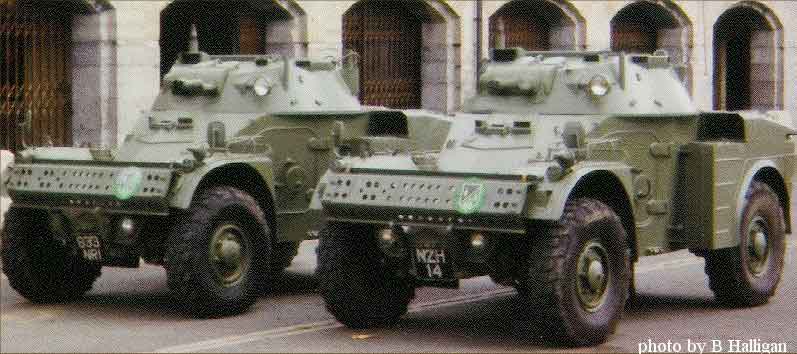
BRDM-1/2; 4-wheeled Russian, about the size of Humvees; gasoline engined; fireball deathtraps if they hit mines; one of the few captured vehicles the Israelis will have next to nothing to do with.


EE-9. The Brazilian *Cascavel*, a 6-wheeler. Again, a non-standard 90mm gun and only carrying a 3-man crew. Useful for airfield and motor pool defense and such projects if some amo for that main gun can be arranged- NOT the same ammo as for the French AML 90, unless the Iraqis had gotten creative.

800 to 900 BMP-1/2.
Now we're getting somewhere. Essentially the Soviet version of a Bradley, with a decent engine and usable armament. 73mm recoilless rocket launcher for the BMP-1 [I don't know if there's a canister round available for it but I don't think so] and a 30mm similar to the 25mm on our Bradley on the BMP-2. They might be better to rebuild and save for the reemerging Iraqi Army we're organizing and training, rather than run them to death on routine patrols over the next couple of years. But they're vulnerable to mass RPG attacks, as the Russians learned in Afghanistan and Chechnya, and the Russians are turning theirs into light tanks/LAV killers, fitting them with 100mm guns with a 4KM kill range. They're amphibious, probably not a big deal in Iraq. The top armor is weak, the fuel tanks are in the rear doors, and there's limited elevation for the main gun.


MT-LB; Here we go. Possibly the best and most versatile vehicle to come from the former Soviet toybox. THE vehicle of choice for Russian infantrymen in Chcehnya, particularly the versions with the 30mm gun Kliver turret fitted. If a tracked Infantry squad carrier is required, this is the one to go with, depending on numbers available. Cream of the crop.


ERC-90; The French Marine, Foreign Legion and cavalry 6x6 armored car that replaced the AML90. Much improved 90mm gun, said to have been designed to deal with a T55 or T62 tank on equal terms headon. Amphibious, of course, and also available in a twin 30mm gun AA version.
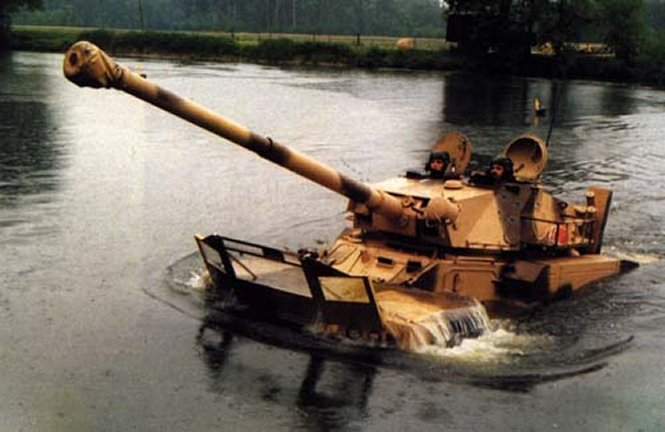

Panhard M3;
An armored box atop a 4-wheel AML-90 chassis. Makes a pretty fair armored ambulance, or half-squad carrier. Used to be used by the Irish UN peacekeepers, and called *the bathtub* by them, as it looks like one upside-down.

PSZH-IV; Hungarian 4-wheeled version of the BRDM; AKA the FUG70. Diesel engined, but very thin armor [amphibious] and lightly armed [14.5mm gun] Probably could hand a Stryker its lunch, but an armored car better suited to MP and convoy escort use than infantry use.

BTR-50; Essentially a PT76 tank with an open crew compartment instead of a turret and gun. Amphibious. No crew exit doors, they just scamper over the sides. The Czech OT-62 is similar but improved. Replaced in Soviet service long ago by the BMP and MT-LB.
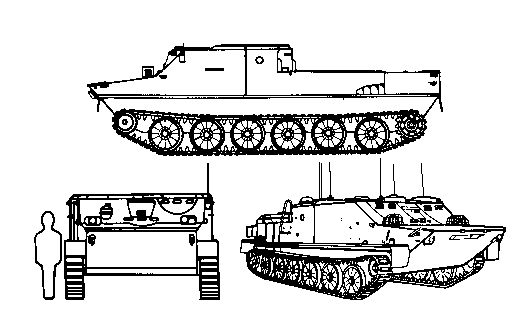

BTR-60; Eight-wheel Russian armored cars, earlier versions of the 4th generation BTR-90. Gasoline engines in early versions. RPG magnets. Kill the tires on one side, and they're a sitting duck. Thin top armor, and a 15-pound AT mine from beneath or a 82mm mortar round from above turns one into scrap.
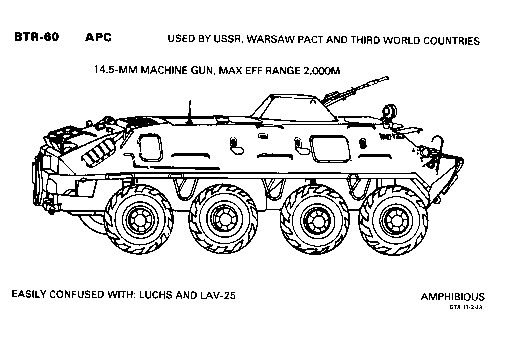
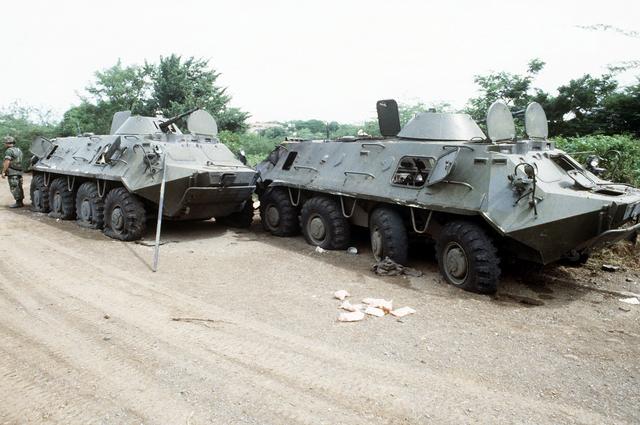
BTR-152; Basicly a 6x6 truck with armored cab and cargo bed. Mechanically dubious, but if we wanted to field some instant gun trucks, these would be a good start. Likely could be reworked to use old M35A2 multifuel Diesel engines easily enough.

EE-11; The Urutu or Jararaca, from Brazil. Lightly armed, a 6x6 very similar to the Cadillac Gage V-150. Another amphibian.
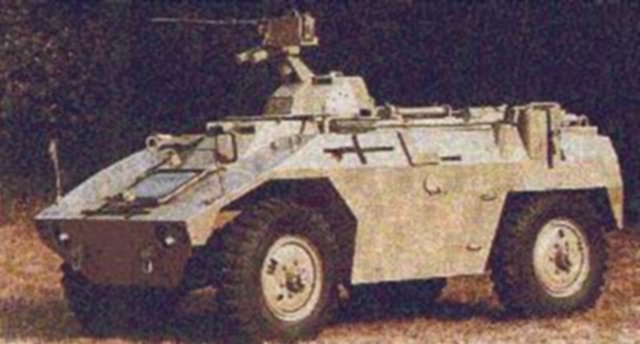
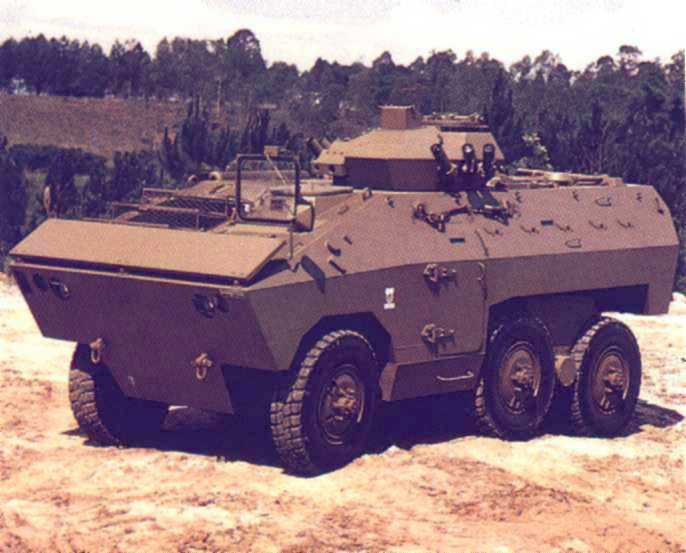
OT-62; The chassis of a PT76 tank without a turret and an open-topped personnel compartment instead; a rough equivalent to the Marine LTVP. There's a recoilless rifle version used as a tank destroyer that was a pretty capable threat to anything less than an M1 tank, which could become a personnel carrier pretty quicklyt by removing the gun. Probably a better use for the chassis than the PT76s, which could be cannibalized for parts to keep the APCs going for a while. Nothing spectacular, but an okay bread-and-butter tracked APCs. India and Pakistan still use the things, I think, suggesting they're rugged enough to last under pretty harsh conditions of use.


OT-64; The Skot. The Czech and Polish idea of what the BTR 60/70 should have been, based on the Czech Tatra 8x8 truck chassis. Many armament and equipment versions, essentially what the Stryker hopes to be. The early Shots were much better vehicles than the Russian BTR 60/70, the BTR 80/90 are probably about equal.
The Finns were impressed enough with theirs that they copied them as the 6X6 SISU. If I had to be in a wheeled APC that took a hit from a TM56 antitank mine, this'd probably be it.


Walid; Egyptian version of the BTR-152, but 4X4, powered by a 168 HP Diesel. 3/8-inch/8mm armor plate, arranged a little differently than a BTR 152.

Type 531; Chinese version of an M113, but with only 4 roadwheels. Sized for smallish Orientals. Mechanically doubtful, but mounts a 12,7mm DShK mg, easily replacably with an M2 .50 or very usable itself. If Wal-Mart ever starts selling APCs, this'll be the model they push.


20 × M113A1; Good ol' Buckets. I hope these are getting the use they deserve. If not in use, I'd hope they get these 20 up and running and park them on a C130 airstrip just in case we suddenly need about 500 people in armored vehicles in or around one of the Iraqi cities. Back 'em up with some BMD's and we'd have an immediately availabvle reaction force not having to think about mines on the roads they were taking to the problem, at least; once they got there it'd be another matter.
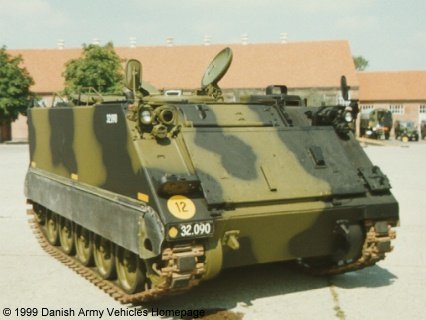
M-60P; M113 copy from Serbia, said to be a pretty good one. Also a neat AAA version with 3 20mm AA guns, that'd make a nice countersniper weapon.

BMD-1. The Russian airborne's all-purpose workhorse. Amphib, with the same 73mm low-pressure gun-rocket launcher of the BMP-1. Now that we've put the Anti-RPG slat cages on the Strykers, it might make sense to park a few dozen BMDs on a C-130 capable airfield in the event we need to airlift a couple of companies of tracked infantry somewhere in a hurry. I bet the 73mm gun could be replaced with a .50 easily enough, maybe a pair of 'em. And of course they can be airdropped...the Russians do it with the crews inside.
133
posted on
11/24/2003 6:03:24 PM PST
by
archy
(Angiloj! Mia kusenveturilo estas plena da angiloj!)
To: PsyOp
We aim to please. : D < big grin >
You must be a very proud. My daughter is 17, but I can hardly imagine her as a soldier, even though two of her brothers are Marines.
Can she shoot and keep her weapon clean, Daddy?
134
posted on
11/24/2003 6:21:30 PM PST
by
Cannoneer No. 4
(Old soldiers never die. They just go to the commissary parking lot. and regroup.)
To: archy; cavtrooper21
That is one helluva post.
IF the need for armored vehicles is so great, why is more use not made of what is available in theater?
I am mostly concerned about the ex-Iraqi wheeled armor. We took our guys out of Bradleys and M113's. If we are going to put them back in tracks they may as well be the ones they came out of. The 82nd and 101st could use some tracks, if they would let them.
Seems like the AML's and the Cascavels and the ERC-90's could be used alongside MP ASV's. The whole damn country is an ammo dump. Put out a reward for French and Brazilian 90mm and some will appear. I don't expect they will have a huge number of main gun targets to service. Do the French make a canister round for their gun?
The Panhard and the PSZH-IV appear useful for motorized patrol. The Hungarians are on our side.
2nd ACR should grab up all the BTR-60's and practice being a BTR Brigade Combat Team.
You probably have some hands-on experience with the BTR-152. I think this would work. Mechanical reliability aside, IF the need for armored patrol vehicles is that dire, BTR-152's are cheap and available. The Poles and the Romanians are on our side. Reengine them with stuff out of Saddam's motor pool.
Give the Urutu to the MP's to run with ASV's.
What excuse do they have for not using every running OT-84 in Iraq?
I think Humvee riders could ride in Walids. Haven't those been around since the Suez Crisis?
135
posted on
11/24/2003 6:50:21 PM PST
by
Cannoneer No. 4
(Old soldiers never die. They just go to the commissary parking lot. and regroup.)
To: blanknoone
Good points that I had not considered. In regards to the amount of tail at Brigade level and higher, our Brigade had a support battalion. Now, this is purely anecdotal, but they were absolutely worthless. This didn't fix a damn thing, we got no resupply, and they actually redeployed about a month before us - as if that wasn't the ultimate demonstration of their uselessness. I don't know how the amount of tail is justified. It seems to me that a mech battalion should easily be able to operate independently in an environment such as Iraq. This seems even more feasible if Iraq is overhauled by Brown and Root, like in Bosnia. All the refueling, mechanical work, and other logistics being handled by civilian contractors.
136
posted on
11/24/2003 7:03:26 PM PST
by
Voice in your head
("The secret of Happiness is Freedom, and the secret of Freedom, Courage." - Thucydides)
To: PsyOp
137
posted on
11/24/2003 8:36:40 PM PST
by
Cannoneer No. 4
(Old soldiers never die. They just go to the commissary parking lot. and regroup.)
To: Cannoneer No. 4
IF the need for armored vehicles is so great, why is more use not made of what is available in theater? I am mostly concerned about the ex-Iraqi wheeled armor. We took our guys out of Bradleys and M113's. If we are going to put them back in tracks they may as well be the ones they came out of. The 82nd and 101st could use some tracks, if they would let them.
They REALLY miss their Sheridans. A Humvee with a TOW launcher does NOT quite deal with the same tasks with the same levels of efficiency. Maybe they'll get the M8 AGS.... Someday.
Seems like the AML's and the Cascavels and the ERC-90's could be used alongside MP ASV's. The whole damn country is an ammo dump. Put out a reward for French and Brazilian 90mm and some will appear. I don't expect they will have a huge number of main gun targets to service. Do the French make a canister round for their gun?
The ALM-90 gun is a low-pressure number and may not be suitable with canister. But the South Africans got good results with HE and HEAT rounds, and I bet a WP round could be fielded real quickly.
I'm less certain about the EC-90 Cockerill 90mm/L36. But the Brazilians and Norwegians have used them, so it's at least possible, and it wouldn't surprise me if the Belgians had some sort of APERS round available. The Norwegians used them as a replacement for the 75mm in the M24 light tank, so they may have something available for the L36/90.
The Panhard and the PSZH-IV appear useful for motorized patrol. The Hungarians are on our side. The Hungarians replaced the PSZH-IV as recon vehicles with their BMP-1F recon track. But they likely have some support troops and mechanics familiar with the maintenance requirements of their older wheelie, and would be willing to give us a hand keeping the things going.
2nd ACR should grab up all the BTR-60's and practice being a BTR Brigade Combat Team.
The BTR60s are twin-mogas engined and lack the side access doors of the BTR 80 and 90; I'd rather see them reworked and re-engined for use by whatever Iraqi stabilization force results. But we might get a little use out of some of the early prototype rebuild models, and maybe some of the upgrades of the later models can be applied to the earlier BTR-60 and -70- like the side exits.
You probably have some hands-on experience with the BTR-152. I think this would work. Not much; I've ridden in Israeli reworked BTR-152s set up as antiaircraft [TCM-20 twin 20mm guns on the old M55 quad-.50 mount] and radio maintenance vehicles. They ride hard, but on-road they're usable, about like a ride in an engineer 5-ton dump truck.
Mechanical reliability aside, IF the need for armored patrol vehicles is that dire, BTR-152's are cheap and available. The Poles and the Romanians are on our side. Reengine them with stuff out of Saddam's motor pool.
We could. Or we could use the thousands of low-hour LD 456 multifuel engines being taken out of M35A2 Duece-and-a-halfs as they're rebuilt into M35A3s with Caterpillar, 6.6-liter 6-cylinder turbo diesel engines. I wouldn't even be surprised if the 150 HP Diesel in a Humvee might not do to bad in one, remember that they'll pull a 5/4-ton Humvee plus a 5/4 ton trailer.
Give the Urutu to the MP's to run with ASV's.
I don't know how many ASV's the Army ever actually procured, nor how many [if any] have made it to Iraq. But even the Urutu would be better than a plastic-body Humvee.
What excuse do they have for not using every running OT-84 in Iraq?
Afraid that the guys would get used to having a wheelie with a roof gun that actually works, maybe? I bet a Mark 19 40mm would go in where the 14.5mm KPV mounts with very little difficulty...and I know how I could find out REAL quick.
I think Humvee riders could ride in Walids. Haven't those been around since the Suez Crisis?
I think there's a picture of Egyptian President Sadat in one of the 4-wheel Walids during the 1967 Arab-Israeli war, back when they were fairly new; before that they used 6-wheeled BTR-152s, deleting one axle for their shorter/lighter copy. The 6-wheel BTR-152 has been around since 1950, and the Israelis operate more than 1500 of them, which they obtained in 1956, '67, and '73.

138
posted on
11/25/2003 1:37:57 AM PST
by
archy
(Angiloj! Mia kusenveturilo estas plena da angiloj!)
To: archy
Way back when we had the opportunity to compare the 20 mm and .50. We preferred the higher rate of fire, ease of loading, ease of maintenance and lighter weight of the .50. The chain guns and other light cannons are good against vehicles, but not much better than a machine gun against people – and people are the problem, not vehicles.
A good old fashioned low tech 5 ton fitted with armor plate and a few machine guns would do nicely.
To: R. Scott
Way back when we had the opportunity to compare the 20 mm and .50. We preferred the higher rate of fire, ease of loading, ease of maintenance and lighter weight of the .50. The chain guns and other light cannons are good against vehicles, but not much better than a machine gun against people – and people are the problem, not vehicles. A good old fashioned low tech 5 ton fitted with armor plate and a few machine guns would do nicely. The Israelis had two situations that came to pass at the same time: the appearance of the Soviet BMD-1 with 73mm rocket-gun and enough frontal armor as to be .50-caliber proof, and the emergence of rotary wing attack helicopters among the Arab armies facing them.
About the same time the Israelis retired the aging Dassault MD 450 Ouragan ground attack aircrasft they'd obtained from France in the early 1950s. And those aircraft mounted four 20mm guns apiece, enough to outfit two of the rebuilt M16 halftrack gun mounts. The 20mm could either reply against fast-moving aircraft of fighters, or could be used for ground support against troops or light vehicles, including the BMD.
I made a similar discovery to yours, but for different reasons. Our battalion used four of the M114A1E1 tracked recon vehicles with the M139 20mm autocannon, that itself worked okay, but which suffered feeding problems with the power turret mount setup. Accordingly, while our guns were off to Ordnance for some more parts changes and upgrades, we mounted a single .50 M2 HB TT on the power mount, quite a step down from the 20x139mm autocannon. Worse, when the 105-round box of ammo ran empty, the commander had to reload manually, from an exposed position. Worse, the M2 used the same linked ammo as all the other M2 .50s in Headquarters company- the tracked vehicle retreivers, mortar tracks, ground surveillance, and supply and cook section trucks. The tanks in our line companies, on the other hand, used the M85 .50 in M9 link belts. And the M114s worked out in the field with the M60s, not *in the rear with the gear.* And when one tank got turned in to Ordnance after a fire, a creative scout team platoon leader and an innovative HHC armorewr spent a couple of days with the temporarily excess gun, and with a little assistance from the motor pool's welder, fabricated a mount that fitted the spare M85 where an M2 had been. A couple of cures for the limited supply of ammo were worked on, ranging from the use of a modified 5-gallon jerrycan to hold ammo belts, to the *tombstone* 225-round can of a quad .50, to coiling a long belt of .50 ammo on a *pan* cut from the lower 12 inches of a 55-gallon oil drum.
The battalion commander was impressed enough to authorize building three more mounts for the 3 other recon tracks, with the guns coming from the three M60A1 tanks in the Headquarters Company tank section- the HHC tankers were glad to get externally mounted .50s that could be used on their external gun mounts, and they were around the HHC sources of ammo supply. The recon teams were glad to get the ammunition commonality with the line tank crews and the choice betweeen standard and *fast fire* offered by the M85 .50, nearly double that of the Infantry gun. But with that powered mount suitable for the weight of the light cannon and its ammo, it dibn't take long for one track to be set up to take three guns, two side-by-side in back and one set a bit forward. The official paperwork on the arrangement was submitted, and 7th Army headquarters ordered a live fire test be made at the Grafenwohr gunnery range complex. The four vehicles were loaded aboard flatbed semis, with three guns each borrowed from the tank crews.
12 .50 MGs, with twice the rate of fire of the M2 Browning .50...it was impressive, especially at night, with tracers. In fact, the three guns set on the high rate actually exceeded the rate of a quad-.50 AA gun mount, at least until the ammo ran out. In practice, the forward gun was usually set on the slow rate, and the rear two fast, since the front gun was the hardest to reload. But in all, the setup was very reliable, and the films taken of the tracks engaging moving targets and shot-up tank hulks was as good as anything from Hollywood. It worked.
The test unit returned home, and the borrowed tank guns were returned to their rightful users...but the mounts stayed fitted, as guns could be scrounged if necessary, at least enough for twin guns on each of the four tracks. Eventually, the M114 was replaced with an M113A1 configured for a scout team, and the two extra M60 MGs made up for the massed firepower of the multiple .50s.
But it's worth remembering what a couple of hot-rodding tankers with a couple of extra guns and some cut-and0try engineering skills can come up with. And it's not just limited to tacking on an extra MG where it wasn't planned by an ordnance engineer....
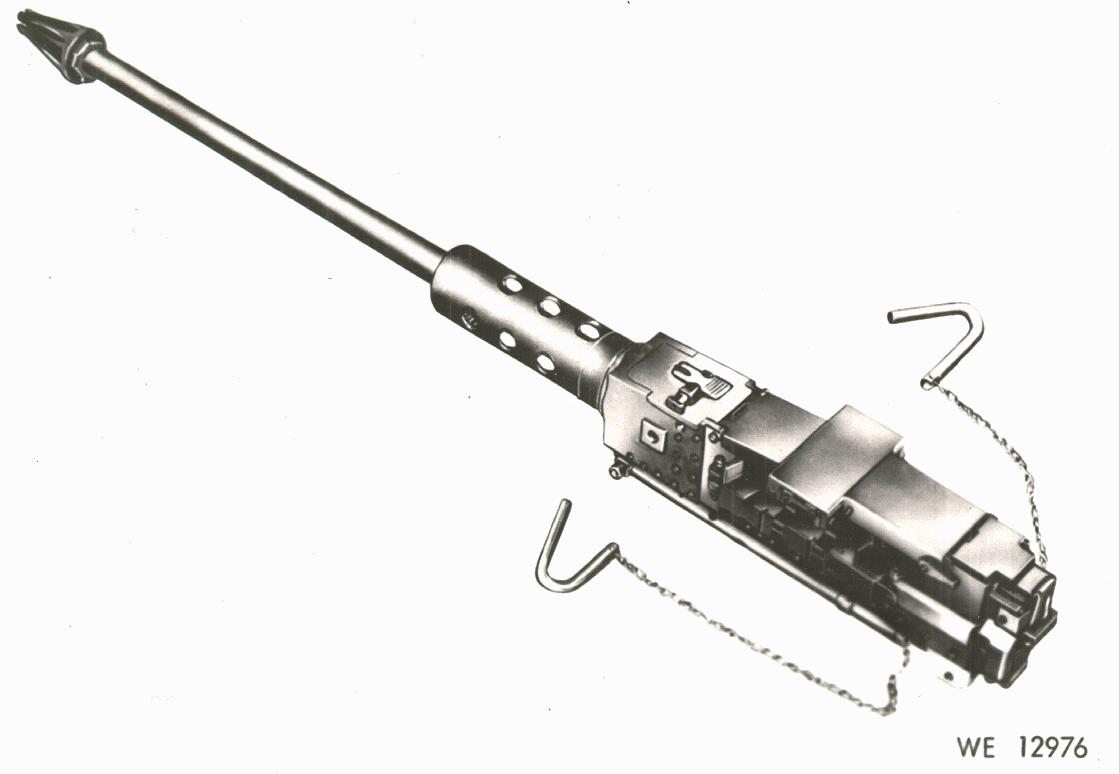
140
posted on
11/25/2003 4:48:51 AM PST
by
archy
(Angiloj! Mia kusenveturilo estas plena da angiloj!)
Navigation: use the links below to view more comments.
first previous 1-20 ... 101-120, 121-140, 141-160 ... 241-257 next last
Disclaimer:
Opinions posted on Free Republic are those of the individual
posters and do not necessarily represent the opinion of Free Republic or its
management. All materials posted herein are protected by copyright law and the
exemption for fair use of copyrighted works.
FreeRepublic.com is powered by software copyright 2000-2008 John Robinson

































